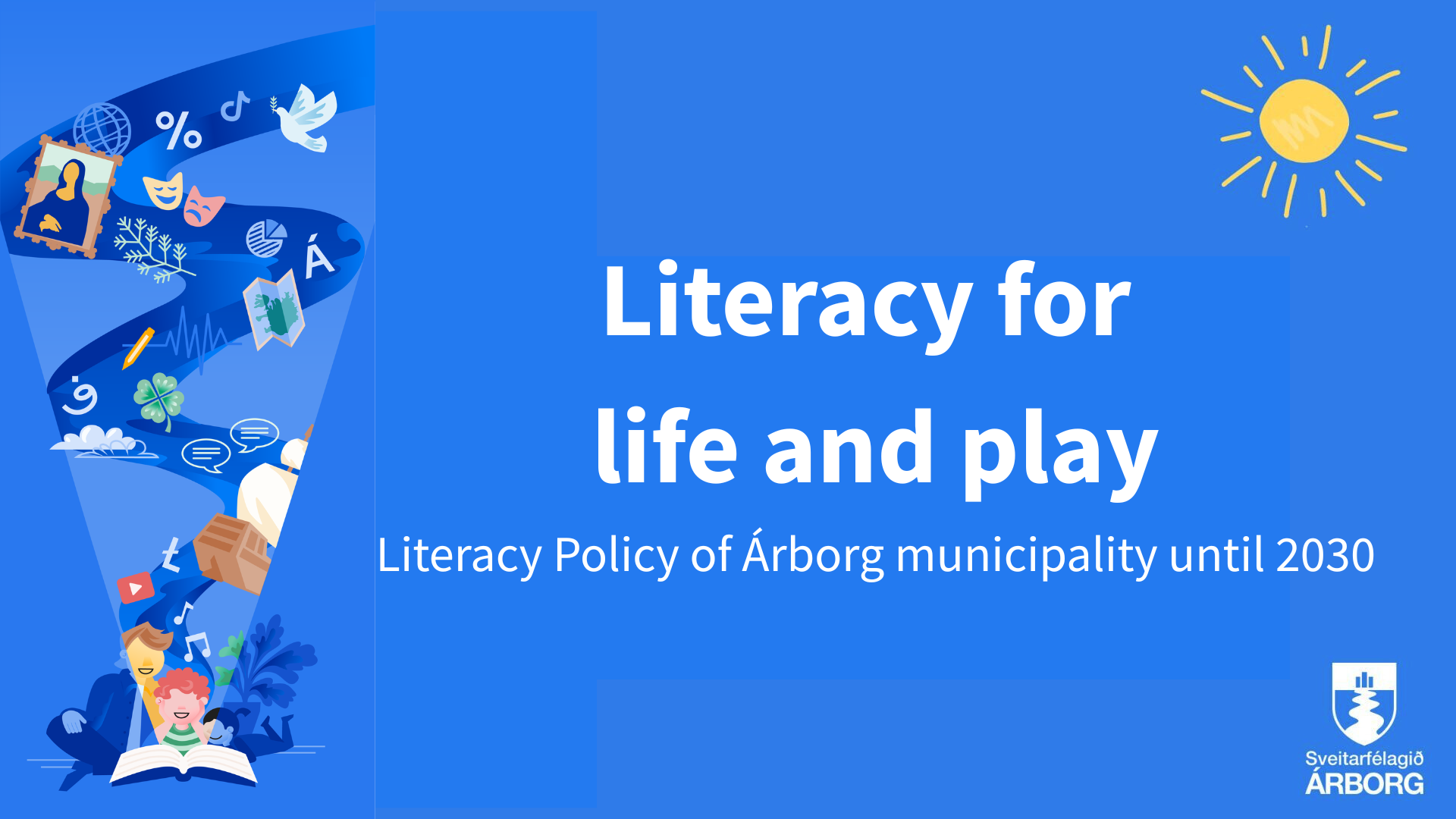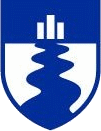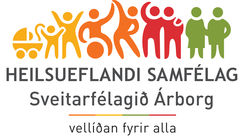Literacy for Life and Play
Literary Policy of Árborg municipality until 2030
Árborg's Literacy Policy for 2030 is titled Literacy for Life and Play and is one of the sub-policies of Árborg's Educational Policy. The policy is based on the current national curricula for preschools and primary schools, the thematic booklet for after-school centers, as well as the Convention on the Rights of the Child and the United Nations Global Goals. The literacy policy is the result of interdisciplinary work by representatives of preschools and primary schools, after-school institutions, and school services. Suggestions were sought from parents regarding the policy.
The policy emphasizes that all children and adolescents in Árborg's school and leisure activities can use literacy for life and play, and the goal is that the policy will be useful for children, adolescents, parents, teachers and others involved in upbringing.
The Literacy Policy is divided into two main sections, on the one hand, language development, reading and writing, and on the other hand, literacy in a broad sense.
Árborg's Literacy Policy was approved by the municipal council on 20 August, 2025 and published on 21 August, 2025. The implementation of the policy will begin in the 2025-2026 school year and will go hand in hand with the implementation of the Árborg Education Policy. The focus points of the Literacy Policy will be reflected in school curricula, work schedules and action plans in all school and leisure activities in the municipality.

The main objective of the policy
The main objective of the Literacy Policy is for children and adolescents to be able to read, understand, interpret and work critically with written language, numbers, pictures and symbols, thus creating meaning that is useful and enjoyable for them in learning and play.
The Literacy Policy is intended to promote children and young people becoming active participants in society and receiving equal opportunities to develop literacy in a broad sense. Good collaboration between homes, schools, and leisure activities plays an important role in ensuring that children and adolescents will prosper in everyday life and acquire skills that will be useful to them in the future.
The role of families and cooperation with school and leisure activities
From birth, parents play a key role by nurturing language development in a targeted manner through communication and conversation with the child. Emphasis must be placed on talking to the child, using a variety of inflections and rhythms, and in this context, repetition is very important. The language acquisition develops in several stages at different speeds depending on the individual.
Collaboration between homes, schools, and leisure activities is an important factor in the literacy of children and adolescents. Once a child starts school, parents continue to play a key role in literacy learning in collaboration with school and after-school activities.
It is important to create a literacy-encouraging environment in homes and in all school and leisure activities with the aim of promoting a positive experience of literacy, sparking interest in learning, and strengthening the self-image of children and adolescents for the future.
Emphasis is placed on supporting families with diverse linguistic and cultural backgrounds to foster both Icelandic and the child's native language. Rich communication in the family's strongest language at home strengthens both the language development and learning of children and adolescents, and parents are encouraged to place great emphasis on supporting reading and conversation in their strongest language in addition to Icelandic.
Language development, reading and writing
Language development
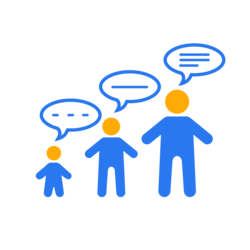 Language development and literacy are both
long-term processes that are in constant development throughout life. These are
interconnected factors and it is important to work with them systematically at
all ages. The three aspects of language development that are most closely
related to literacy and, consequently, academic progress are:
Language development and literacy are both
long-term processes that are in constant development throughout life. These are
interconnected factors and it is important to work with them systematically at
all ages. The three aspects of language development that are most closely
related to literacy and, consequently, academic progress are:
· Phonemic awareness (sensitivity to the sounds of language)
· Vocabulary (the basis of reading comprehension)
· Language comprehension and expression (foundation of reading comprehension and writing)
In preschools in Árborg, great emphasis is placed on language stimulation in a variety of ways through play, work, and daily activities. Systematic language stimulation involves improving children's vocabulary and conceptual understanding, thereby laying a good foundation for literacy and future learning. All opportunities that arise in everyday life are used for conversations or games that test language skills, promote critical thinking and reasoning.
As children age, it is important to continue supporting their language development, as a good vocabulary is the foundation of good reading comprehension. In Árborg's primary schools, specific learning vocabulary is systematically used to facilitate the use of words in understanding and processing the teaching material, including in discussions, answers and re-tellings.
Daily reading of books in all school and extracurricular activities is one of the most effective ways to enhance vocabulary. Reading books is also an ideal opportunity to improve listening, attention, reasoning, and memory.
Reading
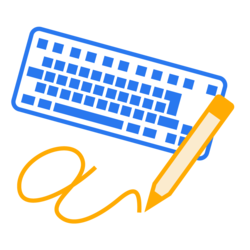 The foundation for children's literacy is laid at
preschool age, as they build their knowledge through discoveries about the
written language in their environment, through reading books and
language-enhancing interactions. Children's interest, free play, and adult
stimulation play a key role here. More emphasis should be placed on the
connection between letter and sound rather than on targeted letter insertion.
Reading from a young age is very important for increasing vocabulary and support language awareness which is a great strength
when traditional reading instruction begins. Children will be more prepared to
learn reading and writing if they have had meaningful interactions from an
early age, have a good command of language expression and comprehension, and
possess a rich vocabulary. It is important that children also learn to read
pictures and symbols and be able to use this form of expression themselves if
necessary.
The foundation for children's literacy is laid at
preschool age, as they build their knowledge through discoveries about the
written language in their environment, through reading books and
language-enhancing interactions. Children's interest, free play, and adult
stimulation play a key role here. More emphasis should be placed on the
connection between letter and sound rather than on targeted letter insertion.
Reading from a young age is very important for increasing vocabulary and support language awareness which is a great strength
when traditional reading instruction begins. Children will be more prepared to
learn reading and writing if they have had meaningful interactions from an
early age, have a good command of language expression and comprehension, and
possess a rich vocabulary. It is important that children also learn to read
pictures and symbols and be able to use this form of expression themselves if
necessary.
When a child reaches elementary school age, the goal of learning to read is to achieve effective reading comprehension. To achieve good reading comprehension, children and adolescents need to possess both decoding skills and good language comprehension. Decoding is related to the technical side of reading and involves connecting letters and sounds. Language comprehension focuses on language skills such as its structure, vocabulary, rhetorical skills, grammar, and pronunciation. When the technical aspects of reading and language skills are built on a solid foundation, the chances of good reading comprehension are increased. To ensure that everyone has a good grasp of reading, children are assessed regularly and intervention is provided when necessary.
At Árborg, the focus is on supporting children's and adolescent's reading development by closely monitoring the progress of skill components, such as phonemic awareness, vocabulary, and reading speed. This is done by analyzing where children and adolescents are in their development at each time and monitoring their reading skills in terms of both reading speed and reading comprehension. To analyze and assess skills, a variety of assessment tools are available to teachers at any given time. On the Árborg Literacy Policy website, you can find an assessment tool table and the criteria used. Emphasis is placed on teachers having knowledge of reading development and teaching methods in order to be able to provide appropriate guidance.
Writing
 Writing
is one of the factors that plays an important role in the studies of children
and adolescents. From a young age, children need to be given opportunities to
express themselves through written language, both in studies and play. Doodling
and graphic expression are the first steps in the development of writing and
form an important foundation for written language skills. Árborg's preschools
support this development by creating an environment where letters and written
language are visible, access to materials is guaranteed, and children are
encouraged to write, draw, and create their own meaning through play.
Writing
is one of the factors that plays an important role in the studies of children
and adolescents. From a young age, children need to be given opportunities to
express themselves through written language, both in studies and play. Doodling
and graphic expression are the first steps in the development of writing and
form an important foundation for written language skills. Árborg's preschools
support this development by creating an environment where letters and written
language are visible, access to materials is guaranteed, and children are
encouraged to write, draw, and create their own meaning through play.
Writing has a strong connection to the development of reading, but in addition to understanding the relationship between letters and sounds, knowledge of the language in which it is written has a great influence. Writing is the key to children and adolescents learning to shape and communicate their own thoughts, ideas, knowledge, and experiences. Through reading, children become familiar with different types of texts and gain blueprints for their own writing, as written texts can vary in length, form, and presentation. A child who reads a lot or has been read to has an advantage when it comes to composing their own texts.
In Árborg's primary schools, emphasis is placed on ensuring that writing instruction covers all aspects of writing, both technical and conceptual. The development of writing skills depends on many factors in children's development, and therefore teaching and guidance are very important. Writing projects that have a clear purpose and are related to the daily lives of children and adolescents are important. The purpose of writing is to communicate content to others and to keep track of one's own thoughts, knowledge, and ideas.
In all school and leisure activities, efforts should be made to ensure that writing becomes a natural part of the studies, communication and creative work of children and adolescents.
Multiculturalism
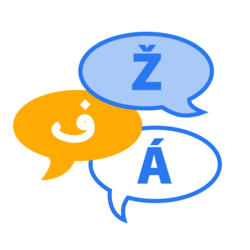 Árborg
is a multicultural community where different linguistic and cultural
backgrounds are viewed as a resource, and this vision is reflected in all of
the municipality's school and leisure activities. Children and adolescents who
grow up speaking more than one language need a rich linguistic environment,
both at home and in school and leisure activities. It is important that
language stimulation at home takes place in the child's native language or
strongest language, thus laying a solid foundation both for learning Icelandic
and general language skills.
Árborg
is a multicultural community where different linguistic and cultural
backgrounds are viewed as a resource, and this vision is reflected in all of
the municipality's school and leisure activities. Children and adolescents who
grow up speaking more than one language need a rich linguistic environment,
both at home and in school and leisure activities. It is important that
language stimulation at home takes place in the child's native language or
strongest language, thus laying a solid foundation both for learning Icelandic
and general language skills.
In school and leisure activities, emphasis is placed on creating opportunities for children and adolescents with diverse linguistic and cultural backgrounds to strengthen both their mother tongue and Icelandic. It is important to ensure that children and adolescents are in interactive communication with both adults and peers who can support their Icelandic skills. A rich vocabulary and a good Icelandic language environment in school and leisure activities have a positive effect on reading learning and increase the opportunities for multilingual children and adolescents to participate actively. An Icelandic language environment needs to be accessible, warm and supportive with an emphasis on vocabulary, conversation and diverse language use.
The handbook Multicultural Education in the Municipality of Árborg, which can be accessed on the municipality's website, contains practical information for staff about the reception process when welcoming children and young people with diverse linguistic and cultural backgrounds. It also includes ideas for teaching methods, as well as various types of educational material, including on the language development and vocabulary of multilingual children and adolescents. Emphasis is placed on ensuring that all school and leisure staff are familiar with the handbook and use it in their work.
Literacy in a broad sense
Literacy is a vast skill that is related to more factors than language development, reading, and writing. Literacy in a broad sense includes the ability to understand, interpret, communicate and utilize knowledge and information in a variety of ways. The main goal is for children and adolescents to become active participants in society, form their own opinions, develop critical thinking, and understand their emotions and how they are feeling.
Árborg's Literacy Policy is based on the belief that literacy strengthens the identity, language skills, and social participation of children and adolescents. Literacy is also a key factor in ensuring increased academic achievement and cultural understanding. To this end, school and leisure activities create a diverse literacy-encouraging environment where:
· Social and civic literacy enhances social skills, responsibility and active participation in a multicultural democratic society.
· Health literacy supports mental and physical well-being and health.
· Environmental literacy and sustainability strengthen a sense of responsibility towards nature and the environment
· Scientific and numeracy literacy increases scientific understanding and critical thinking
· Arts and cultural literacy enhances creativity, expression, and understanding of culture and the arts.
· Information and media literacy ensures the responsible and critical use of digital technology, media and information.
Social and community literacy
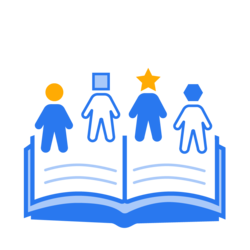 Children's and adolescents' social and community
literacy consists of the ability to have constructive interactions, show
tolerance, and deal with emotions responsibly. Social literacy enhances
self-awareness, communication, and critical thinking. Civic literacy involves
active participation in society and an understanding of democracy, diverse
values, and people's cultural backgrounds.
Children's and adolescents' social and community
literacy consists of the ability to have constructive interactions, show
tolerance, and deal with emotions responsibly. Social literacy enhances
self-awareness, communication, and critical thinking. Civic literacy involves
active participation in society and an understanding of democracy, diverse
values, and people's cultural backgrounds.
Árborg's school and leisure activities emphasize cooperation, active expression, conflict resolution, and respect for diversity. Children and adolescents are given opportunities to form their opinions, participate in democratic work and make decisions regarding their own lives and society. Everyone should feel that their point of view matters.
The goal of social and civic literacy is for children and adolescents to become responsible, critical, and active participants in a democratic, multicultural society.
Health literacy
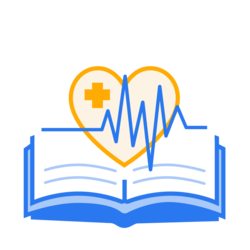 Health
literacy for children and adolescents is the ability to access, understand, and
utilize health-related information to increase physical and mental well-being.
It supports awareness of nutrition, sleep, exercise, prevention, and mental
health.
Health
literacy for children and adolescents is the ability to access, understand, and
utilize health-related information to increase physical and mental well-being.
It supports awareness of nutrition, sleep, exercise, prevention, and mental
health.
Árborg's school and leisure activities create a platform that encourages healthy lifestyles, active participation and exercise. Emphasis is placed on reducing health-related inequalities and providing space to influence one's own health and well-being.
The goal of health literacy is for children and adolescents to learn to take care of their health in a conscious way, adopt a healthy lifestyle, and develop positive attitudes that will benefit them in the future.
Environmental literacy and sustainability
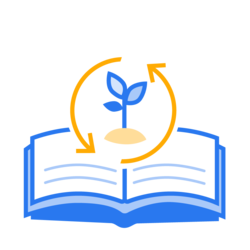 Environmental
literacy and sustainability among children and adolescents lies in the ability
to understand the relationship between humans and nature, assess the impact of
one's own actions, and assume responsibility for sustainable development with
the interests of future generations as a guiding principle.
Environmental
literacy and sustainability among children and adolescents lies in the ability
to understand the relationship between humans and nature, assess the impact of
one's own actions, and assume responsibility for sustainable development with
the interests of future generations as a guiding principle.
Árborg's school and leisure activities provide children and adolescents with opportunities to research and read about their environment, participate in solution-oriented projects, and develop respect and responsibility for nature and the environment. Emphasis is placed on critical thinking, participation, and social responsibility, especially regarding education for sustainability and climate awareness.
The goal of environmental literacy and sustainability is for children and adolescents to learn to enjoy nature and become aware of sustainable development, environmental challenges, and moral responsibility that will benefit them in the future.
Scientific and numerical literacy
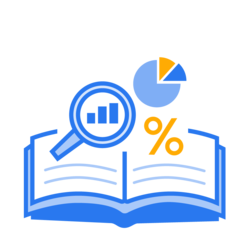 Scientific
and numerical literacy of children and adolescents consists of the ability to
understand and use scientific methods and numerical standards in everyday life.
Scientific literacy increases curiosity, critical thinking, and the ability to
ask questions, gather data, and draw conclusions. Numerical literacy involves
an understanding of numbers, measurements, and patterns that is useful in a
variety of situations.
Scientific
and numerical literacy of children and adolescents consists of the ability to
understand and use scientific methods and numerical standards in everyday life.
Scientific literacy increases curiosity, critical thinking, and the ability to
ask questions, gather data, and draw conclusions. Numerical literacy involves
an understanding of numbers, measurements, and patterns that is useful in a
variety of situations.
Árborg's school and leisure activities provide children and adolescents with opportunities to tackle real challenges through research and experiments. Emphasis is placed on problem-solving, logic, and technical knowledge.
The goal of scientific and numeracy literacy is for children and adolescents to become aware of data and information, be able to make informed decisions, and acquire skills that are useful in an ever-changing environment.
Arts and cultural literacy
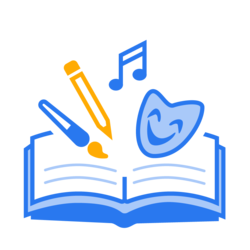 Arts
and cultural literacy of children and adolescents consists of the ability to
understand, appreciate, express themselves, and create through the arts. It
supports, among other things, the development of identity and creativity.
Arts
and cultural literacy of children and adolescents consists of the ability to
understand, appreciate, express themselves, and create through the arts. It
supports, among other things, the development of identity and creativity.
Árborg's school and leisure activities provide children and adolescents with opportunities to experience diverse artistic and operational culture, express themselves through art, and participate in art events and creative projects. Emphasis is placed on freedom of expression, initiative, and participation in the cultural sector of society.
The goal of arts and cultural literacy is for children and adolescents to become aware of the value of arts and culture, develop artistic skills, and gain faith in their own creative power. At the same time, they are given the opportunity to enjoy and understand diverse artistic cultures and participate in cultural events that strengthen their connections with society.
Information and media literacy
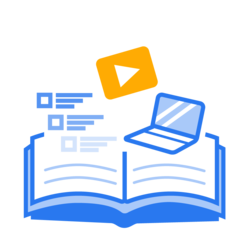 Information and media
literacy for children and adolescents consists of the ability to obtain,
analyze, and utilize information critically and responsibly from a variety of
media. A strong moral sense, the development of critical thinking and active
participation should be promoted.
Information and media
literacy for children and adolescents consists of the ability to obtain,
analyze, and utilize information critically and responsibly from a variety of
media. A strong moral sense, the development of critical thinking and active
participation should be promoted.
Árborg's school and leisure activities emphasize that children and adolescents learn to assess the reliability of information and respect copyright, as well as to share and use content responsibly. Emphasis is placed on security, ethics, and rights in the digital arena.
The goal of information and media literacy is for children and adolescents to become independent, informed, and responsible users of media.

